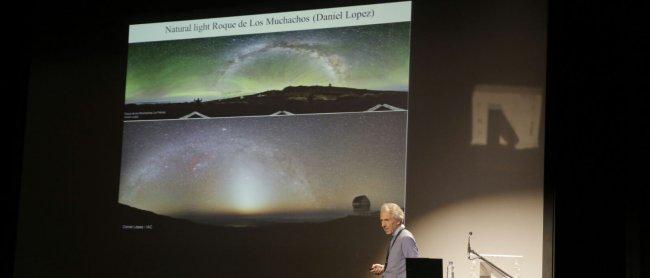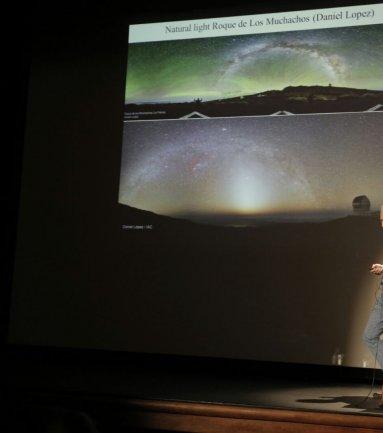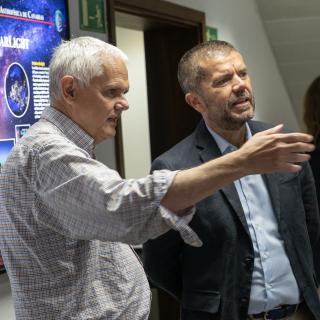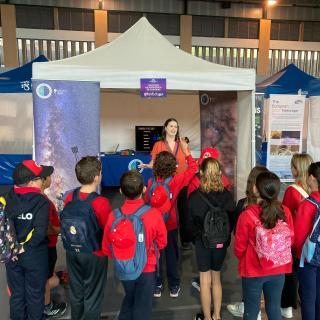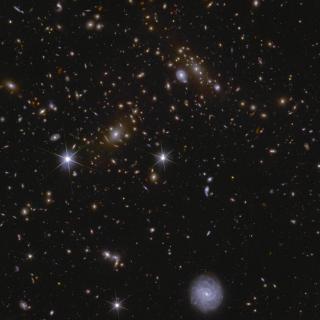The second set of subjects of the conference, moderated by José Franco of the Autonomous National University of Mexico (UNAM) was devoted to the preservation of biodiversity and human welfare. The first lecturer was Sergio Ortolani, a Professor at the University of Padua, (Italy), who talked about the development of light pollution and its impact on astronomical observations, using data from "contaminated" astronomical sites as a guide for the preservation of dark sites. He gave a historical tour of the development of public lighting in urban centres, pointing out that in the 70's of the last century there was a drastic change in street lignting when high pressure sodium lamps were introduced, which are more efficient and less contaminating. "The effect of lighting on the sky background has an effect on the accuracy and the limit to the detection of astronomical sources" He added "The sky is shrinking" meaning the part of the sky which is useful for observations. "We must use all the means at our disposal to fight against the problem, which affects all living things"
David Welch, the President of the Dark Skies Advisory Group of the International Union for the Conservation of Nature (IUCN) concentrated on dark skies and protected areas after a decade since the creation of this group in the United States in 2007. He explained the situation of the national parks and their skies in that year (there were only 10 protected sites, 6 in Canada, 3 in the US, and 1 in Hungary). In 2008 there were already 7 Dark Sky reservations, and a set of guide lines for dealing with outdoor lighting for parks in Canada. Today there are 44 parks, 11 reservations, and 15 communities among other protected areas. At the present time there are considerations of urban parks. There are several different kinds of challenges for protected areas: the need for outreach in urban areas, the inclusion of dark sky values in the running of the parks, and the declaration of astronomy as a World Heritage.
A World Atlas of sky brightness
Alejandro Sánchez de Miguel, of the Instituto de Astrofísica de Andalucía (IAA) referred to the evolution of night-time images obtained by satellites during a decade. He recalled that in the Starlight conference of 2007, an undergraduate student presented the first evidence of the different levels of illumination due to the contamination produced in different countries in Europe. Since then, ten years of research have shown how the dat from the Defense Meteorological Satellite Program (DMSP) and the Visible and Infrared Imaging Radiometer Suite (VIIRS) can help to detect incorrect estimates of energy consumption, as well as to estimate sky brightness. This has premitted the elaboration of the most complete world atlas of sky brightness, comparing measurements from the ground with data from known satellites. Now with the help of images from the International Space Station we can make maps which estimate the impact on human health and on visibility. In addition the images give us a better understanding of the spectrum of the light sources, and whether converting lamps form high pressure sodium to LED are increasing or decreasing light pollution.
There was also an opportunity for Connie Walker, a scientist from the National Optical Astronomy Observatory (NOAO) of the USA to point up the importance of educational and outreach campaigns to avoid the light pollution which may affect the night sky, such as the projects Dark Sky Rangers, in Portugal, Globe at Night, International Year of Light, teaching kits about quality illumination in the US and STARS4ALL. Walker commented that she had been surprised to learn that half of her students in Hawaii had never seen the Milky Way. "How can we change" she asked " a society which has turned night into day? How can we convince people that we have lost something valuable? This led to the role of the International Astronomical Union (IAU) in producing change be a set of activities. "One of these" she said, " is to provide educational platforms for teaching in schools the value of astronomy. The other is to set up working groups in the Commission for the protection of astronomical observing sites, both present and potential, including the possibility of a collaboration between the IAU and UNESCO to declare astronomical observatories World Heritage Sites.
Global Threat
Richard D. Gregory, of University College, London (UCL) and a member of the Royal Society for the Protection of Birds (RSPB) analyzed the effects of light pollution on bird populations. He explained why light is so important for birds, which are animals with complex visual navigation systems. "It is important for their reproduction, feeding, and orientation. In contrast to human beings, who have only 3 types of cones in their eyes, birds have 4, which enhances their ability to see colours" He analyzed the potentially catastrophic impact of light pollution on urban birds, such as losing their way during migration, and loss of energy during flight, which turns them into easy prey. Night lighting can also induce daytime or twilight behaviour, changing their life cycles. "Birds which are near to street lights begin their dawn chorus up to an hour early, the females lay their eggs up to a month in advance, and they are affected when they try to find a mate in order to reproduce. Gregory showed a study of 6.8 millions of birds which had died on high tension pylons in the USA. In conclusion we need to improve monitorization as well as to work out strategies for rescue and methods for mitigating the negative effects of lighting. "Light pollution" he stressed " is a global threat to biodiversity".
Ariadna García Saenz, a postdoctoral researcher at ISGlobal, Barcelona Institute for Health, presented a study about the relation between exposure to night-time lighting and the risk of prostate cancer and of breast cancer in Spain. Night work, the exposure to light at night, and the consequent alteration of the circadian rhythms (changes in our biological parameters during regular time periods) can increase, according to this study, the risk of cancers which depend on hormones such as melatonin, which are related to sleep. Previous studies related to light pollution and human health found a positive association, and showed that the duration of the exposure, and the spectrum of the light have greater effects than the light intensity. In follow-up studies the results showed that people run a greater risk of prostate cancer if they sleep in rooms with higher levels of lighting , while women exposed to bluer light have a greater probability of developing breast cancer.
Sybille Schroer, of the Leibnitz Institute of Freshwater Ecology and Inland Fisheries, in Germany, presented her research about light pollution as a multidisciplinary subject. The use of artificial lighting at night (ALAN) has been increasing with human activity in time and space, with an annual world-wideincrease of 3-6%. The boundaries between urban spaces and wildlife areas are blurring, and the habitat available to lightsensitive species is decreasing even in nature conservation areas. In her talk she showed studies of the impact of ALAN on wildlife, and on ecosystems. She also presented the results of four years of work in a network within the framework of the EU-COST action "Loss of Night Network (LONNe) . "LoNNe" she explained, has established cross-disciplinary links, for example between astronomers, ecologists, lighting designers and engineers, to find solutions to the ever growing problems related to light pollution" This network is now involved, as an external member, in the collective conscience platform STARS4ALL, financed by the European H2020 programme, and in which the Instituto de Astrofísica de Canarias is involved, with the objective of starting dialogues about light pollution among all the interested parties, and with the general public".
Jaime Zamorano, of the Complutense University of Madrid, and a member of the STARS4ALL platform, presented the TESS-W photometer, the first version of a series of cheap, reliable photometers which will be used to measure the brightness of the night sky. TESS-W is connected to a router via WIFI and automatically sends the values of the sky brightness to a data archive using Internet protocols. The apparatus includes an infrared sensor for estimating cloud cover. It is designed to monitor the evolution of night sky brightness at fixed positions. The photometer can also be used in a local mode, connected to a computer or a tablet to take data from a moving vehicle. " This photometer" added Zamorano " is being developed with the STARS4ALL platform for increasing the awareness of the general public so as to promote dark skies in Europe".
Press release of the first part of the day: Windows to the universe
